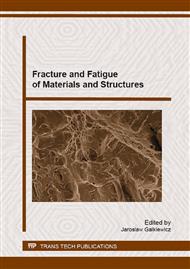[1]
Kocańda S., Szala J., Backgrounds of fatigue calculations (in Polish), 3rd Edition, Polish Scientific Publishing House (Wydawnictwa Naukowe PWN ), Warsaw, (1997).
Google Scholar
[2]
Ligaj B., Influence of selected load programs generated from correlation table, on fatigue life of 18G2A steel (in Polish), Maintenance Problems, JTE-PIB, 3/2007, Radom, (2007).
Google Scholar
[3]
Sempruch J., Strzelecki P., Experimental Verification of the Analytical Method for Estimated S-N Curve in Limited Fatigue Life, Materials Science Forum Vol. 726 (2012) pp.11-16, Switzeland, (2012).
DOI: 10.4028/www.scientific.net/msf.726.11
Google Scholar
[4]
Szala J., Hypotheses on summation of fatigue failures (in Polish), ATR Publishers (Wydawnictwa Uczelniane ATR), Bydgoszcz, (1998).
Google Scholar
[5]
Kacak M., Webster S., Janosch J. J., Ainsworth R. A., Koers R., FITNET, Fitness for Service Procedure – Final Draft MK 7, (2006).
Google Scholar
[6]
Neimitz A., Dzioba I., Graba M., Okrajni J., Assessment of strength, life and operational safety of structural elements containing defects ( in Polish), Publishing House of Swietokrzyska Technical University (Wydawnictwo Politechniki Świętokrzyskiej), Kielce, (2008).
Google Scholar
[7]
Boroński D., Cyclic material properties distribution in laser – welded joints, International Journal of Fatigue, vol. 28/4, (2006).
Google Scholar
[8]
Boroński D., Hybrid method of strain and stress analysis in fatigue crack zone, Archive of Mechanical Engineering, 53, 206.
Google Scholar
[9]
Hobbacher A., Recommendations for fatigue design of welded joints and components, IIW document XIII-1965-03/XV-1127-03, (2004).
DOI: 10.1007/978-3-319-23757-2_8
Google Scholar
[10]
Bureau Veritas rules for steel ships classification – Fatigue check of structural details – Part B, Chapter 7, Section 4 – Edition, (2003).
Google Scholar
[11]
Boronski, D, Soltysiak, R ; Giesko, T; Marciniak, T; Lutowski, Z; Bujnowski, S, The Investigations of Fatigue Cracking of Laser Welded Joint With The Use of FatigueVIEW, System. Fracture and fatigue of materials and structures, Key Engineering Materials Volume: 598.
DOI: 10.4028/www.scientific.net/kem.598.26
Google Scholar
[12]
Tomaszewski T., Sempruch J., Verification of the fatigue test method applied with the use of mini specimen. Key Engineering Materials. 598, (2014).
DOI: 10.4028/www.scientific.net/kem.598.243
Google Scholar
[13]
Pejkowski Ł., Skibicki D., Sempruch J., High-Cycle Fatigue Behavior of Austenitic Steel and Pure Copper under Uniaxial, Proportional and Non-Proportional Loading, Strojniski vestnik-journal of mechanical engineering, Volume: 60, Issue: 9, (2013).
DOI: 10.5545/sv-jme.2013.1600
Google Scholar


